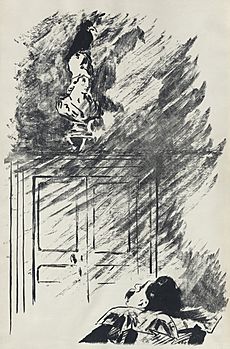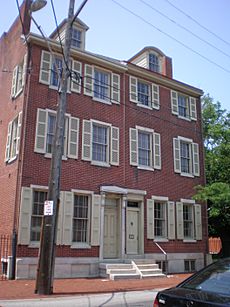Edgar Allan Poe facts for kids
Quick facts for kids
Edgar Allan Poe
|
|
|---|---|

Poe, 1848
|
|
| Born | January 19, 1809 Chelsea, Massachusetts, United States |
| Died | October 7, 1849 Baltimore, Maryland |
| Occupation | Writer |
| Nationality | American |
| Alma mater | University of Virginia |
| Genre | Horror stories Poems |
| Notable works | "The Fall of the House of Usher" "The Tell-Tale Heart" "The Raven" "To Helen" |
Edgar Allan Poe (born January 19, 1809 – died October 7, 1849) was a famous American writer. He is well-known for his spooky horror stories and beautiful poems. Poe is often seen as one of the first writers of detective stories. He also helped create the genre of science fiction.
Contents
Early Life
Edgar Allan Poe was born on January 19, 1809. His parents were David Poe Jr. and Elizabeth Arnold Hopkins, who were both stage actors. His father left the family when Edgar was a baby. When Edgar was two, his mother died, and he became an orphan.
A wealthy man named John Allan took Edgar into his home in Richmond, Virginia. In 1815, the Allan family moved to England. Young Poe went to a private school there. After five years, the family moved back to Richmond, Virginia.
Back in Virginia, Poe started college at the University of Virginia in 1826. He had money problems there, and John Allan became angry, stopping his support. In 1827, Poe published his first book of poems, called Tamerlane and Other Poems. His name was not on the book; it just said 'a Bostonian' wrote it.
Military Life
Poe joined the army, using a different name and saying he was older than he was. He was a good soldier and quickly became a sergeant major. While he was in the army, his foster-mother Frances Allan died. Poe tried to fix things with John Allan.
Poe soon left the army and joined West Point in New York state. Poe did not enjoy his time at West Point and got very bored. He was expelled in March 1831. At this point, John Allan stopped supporting him completely. Other cadets liked Poe. They helped pay for Poe to publish a book of his poems called Al Aaraaf, Tamerlane, and Minor Poems. He soon moved to Baltimore, Maryland.
Life in Baltimore, Philadelphia, and New York
In Baltimore, Poe lived with his aunt, Maria Poe Clemm. She was his real father's sister. Maria also had a daughter named Virginia Clemm. Virginia admired Poe very much. In 1836, when Virginia was thirteen, she married Poe.
Poe was writing a lot during this time. He sold his first short story in 1832. His writing did not earn very much money. He also worked as an editor for different magazines. He became well known for his writing reviews.
In 1842, while Poe was living with Maria and Virginia in Philadelphia, Pennsylvania, Virginia became sick with tuberculosis. The family moved to the New York City area in 1843. They later settled in The Bronx. On January 29, 1845, Poe published his most famous poem, "The Raven". This poem made him very popular. Virginia died a couple years later on January 30, 1847.
Poe's Mysterious Death
Poe's death is very mysterious. On September 27, 1849, Poe left Richmond after a short visit. No one knows what happened to him until October 3. On that day, a man named Joseph W. Walker found him outside of Gunner's Hall in Baltimore. Poe was taken to Washington College Hospital.
While in the hospital, he became very confused and started seeing things that were not there. He died on October 7, 1849. The exact cause of his death is still unknown. Some possible ideas include brain problems, illness, or even rabies.
Poe was buried after a small funeral with only a few people. He was buried in the grounds of the Westminster Church and Burying Ground. Later, on May 17, 1875, Poe was reburied at the front of the churchyard. This happened after people in the city raised money to build a large monument for him. He is buried there with his wife Virginia and Virginia's mother Maria Clemm.
Famous Stories and Poems

Short Stories
- "The Black Cat"
- "The Cask of Amontillado"
- "The Fall of the House of Usher"
- "The Gold-Bug"
- "The Masque of the Red Death"
- "The Murders in the Rue Morgue"
- "The Pit and the Pendulum"
- "The Tell-Tale Heart"
Poems
Other Works
- Politian (1835) – Poe's only play
- The Narrative of Arthur Gordon Pym of Nantucket (1838) – Poe's only complete novel
- "The Balloon-Hoax" (1844) – A fake news story printed as if it were true
Preserved Homes and Museums

No childhood home of Poe is still standing. The oldest standing home in Richmond is the Old Stone House. It is now the Edgar Allan Poe Museum. Poe never lived there, but the museum has many items he used. It also has rare first printings of his works.
The dorm room Poe used at the University of Virginia in 1826 is preserved. You can visit it today. The earliest home Poe lived in that is still standing is in Baltimore. It is now the Edgar Allan Poe House and Museum. Poe lived there when he first moved in with Maria Clemm and Virginia.
In Philadelphia, only one of the houses Poe lived in has survived. This house is now the Edgar Allan Poe National Historic Site. Poe's final home is preserved as the Edgar Allan Poe Cottage in the Bronx.
In Boston, a plaque marks the area where Poe was born. A sculpture of Poe was put up in Boston in 2014. It shows him walking against the wind with a raven flying beside him.
Images for kids
-
Plaque in Boston marking the approximate location of Poe's birth
-
Poe was first stationed at Boston's Fort Independence while in the Army.
-
Edgar Allan Poe is buried at Westminster Hall in Baltimore, Maryland (Lat: 39.29027; Long: −76.62333); the circumstances and cause of his death remain uncertain.
-
1845 portrait by Samuel Stillman Osgood
-
1848 "Ultima Thule" daguerreotype of Poe
See Also
 In Spanish: Edgar Allan Poe para niños
In Spanish: Edgar Allan Poe para niños









